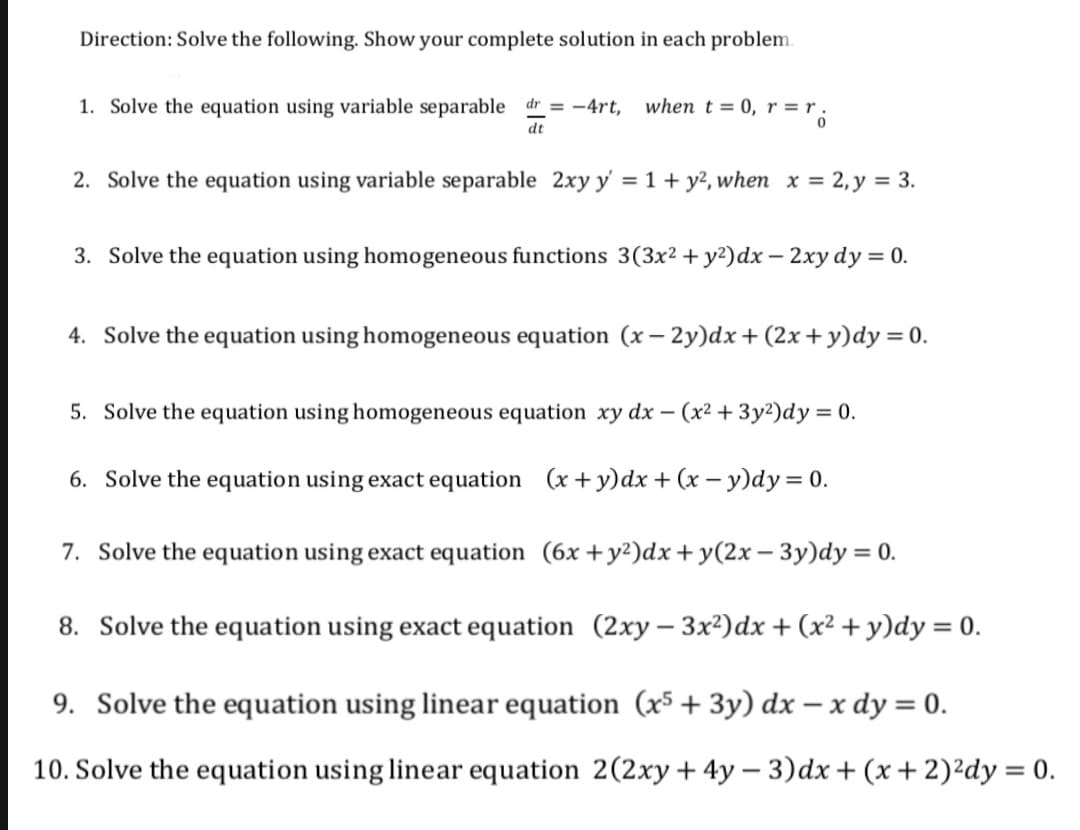Calculus: Early Transcendentals
8th Edition
ISBN:9781285741550
Author:James Stewart
Publisher:James Stewart
Chapter1: Functions And Models
Section: Chapter Questions
Problem 1RCC: (a) What is a function? What are its domain and range? (b) What is the graph of a function? (c) How...
Related questions
Question
No. 4-10

Transcribed Image Text:Direction: Solve the following. Show your complete solution in each problem.
1. Solve the equation using variable separable dr = -4rt, when t= 0, r = r .
dt
2. Solve the equation using variable separable 2xy y' = 1 + y², when x = 2,y = 3.
3. Solve the equation using homogeneous functions 3(3x² + y²)dx – 2xy dy = 0.
4. Solve the equation using homogeneous equation (x– 2y)dx+(2x + y)dy=0.
5. Solve the equation using homogeneous equation xy dx – (x² + 3y²)dy = 0.
6. Solve the equation using exact equation (x + y)dx + (x – y)dy = 0.
7. Solve the equation using exact equation (6x +y²)dx + y(2x – 3y)dy = 0.
8. Solve the equation using exact equation (2xy – 3x²)dx + (x² + y)dy = 0.
9. Solve the equation using linear equation (x5 + 3y) dx – x dy = 0.
10. Solve the equation using linear equation 2(2xy+4y – 3)dx+ (x+2)²dy = 0.
Expert Solution
This question has been solved!
Explore an expertly crafted, step-by-step solution for a thorough understanding of key concepts.
This is a popular solution!
Trending now
This is a popular solution!
Step by step
Solved in 3 steps with 3 images

Recommended textbooks for you

Calculus: Early Transcendentals
Calculus
ISBN:
9781285741550
Author:
James Stewart
Publisher:
Cengage Learning

Thomas' Calculus (14th Edition)
Calculus
ISBN:
9780134438986
Author:
Joel R. Hass, Christopher E. Heil, Maurice D. Weir
Publisher:
PEARSON

Calculus: Early Transcendentals (3rd Edition)
Calculus
ISBN:
9780134763644
Author:
William L. Briggs, Lyle Cochran, Bernard Gillett, Eric Schulz
Publisher:
PEARSON

Calculus: Early Transcendentals
Calculus
ISBN:
9781285741550
Author:
James Stewart
Publisher:
Cengage Learning

Thomas' Calculus (14th Edition)
Calculus
ISBN:
9780134438986
Author:
Joel R. Hass, Christopher E. Heil, Maurice D. Weir
Publisher:
PEARSON

Calculus: Early Transcendentals (3rd Edition)
Calculus
ISBN:
9780134763644
Author:
William L. Briggs, Lyle Cochran, Bernard Gillett, Eric Schulz
Publisher:
PEARSON

Calculus: Early Transcendentals
Calculus
ISBN:
9781319050740
Author:
Jon Rogawski, Colin Adams, Robert Franzosa
Publisher:
W. H. Freeman


Calculus: Early Transcendental Functions
Calculus
ISBN:
9781337552516
Author:
Ron Larson, Bruce H. Edwards
Publisher:
Cengage Learning